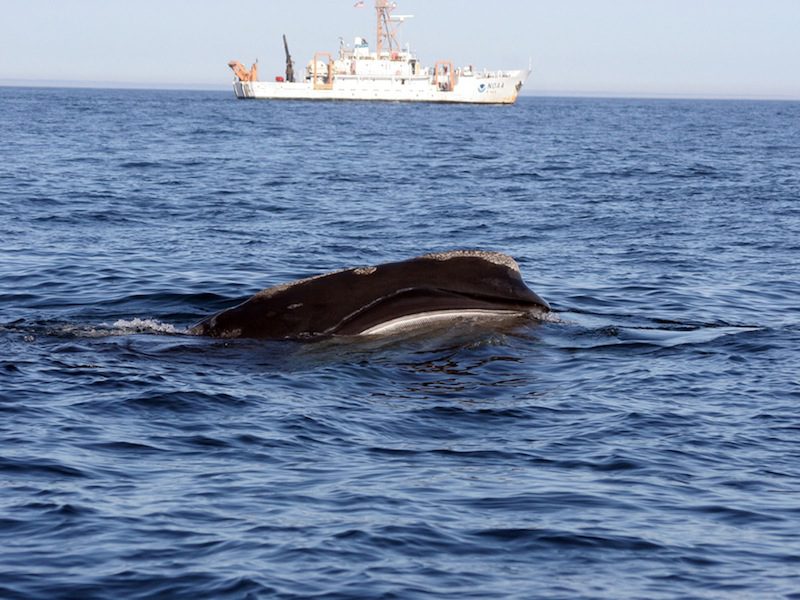Firms in Fed’s Beige Book Fret Over Any Lengthy Baltimore Port Closure
(Bloomberg) — The closure of one of the East Coast’s busiest ports after the collapse of Baltimore’s Francis Scott Key Bridge has so far not led to broad price increases,...


Right whale (Eubalaena glacialis) skim feeding with NOAA ship Delaware II in the background.
NOAA Fisheries Service is seeking comments on its proposal to make permanent the rules it implemented five years ago to reduce the number of collisions between ships and North Atlantic right whales.
Right whales are among the most endangered species in the world, and are highly vulnerable to ship collisions. The rules, part of NOAA’s long-standing efforts to recover right whales, are currently scheduled to expire in December 2013. NOAA’s proposal to make them permanent, which includes a 60-day public comment period, was filed at the Federal Register today.
The existing rules, which reduce an ocean-going vessel’s speed to 10 knots or less during certain times and locations along the East Coast from Maine to Florida, have reduced the number of whales struck by ships since 2008, when the speed limits began. No right whale ship strike deaths have occurred in Seasonal Management Areas since the rule went into place. Modeling studies indicate the measures have reduced the probability of fatal ship strikes of right whales by 80 to 90 percent.
Also, NOAA’s revised estimates indicate that the restrictions cost the shipping industry and other maritime communities about one-third of original 2008 projections. NOAA scientists say that industry participation and compliance is high, and that in most cases vessels have incorporated speed restrictions into their standard operations and voyage planning.
“Reducing ship speeds in areas where there are endangered right whales works,” said NOAA Fisheries’ acting administrator Sam Rauch. “It is a proven method to reduce deaths and serious injury to these incredible creatures. Making these protections permanent will make U.S. East Coast waters safer for right whales, and will allow them to reach full maturity, which is critical to their long-term survival.”
The rule proposes to continue existing speed restrictions during migration periods along three regions of the U.S. East Coast (Northeast, Mid-Atlantic, and Southeast). These measures are implemented during the time of year when right whales occur in each area. Speed restrictions apply to vessels that are 65 feet in length or greater, except federal agency vessels.
The proposed rule also seeks public input on ways to measure the effectiveness of the existing speed restrictions and whether they should be phased out in the future.
This proposed rule is part of a more comprehensive approach to conserve right whales, including consulting on operations of federal ships under the Endangered Species Act, developing an expanded outreach and education program, and modifying shipping routes in waters of Massachusetts, Georgia and Florida. NOAA has also developed a dynamic management program whereby vessel operators are asked to travel less than 10 knots or avoid areas where whales occur in times and places not covered by seasonal speed restriction zones. Scientists expect these actions to significantly reduce the risks to right whales from ships.
The North Atlantic right whale primarily occurs in coastal or shelf waters. Its known range includes winter calving and nursery areas in coastal waters off the southeastern United States, and summer feeding grounds in New England waters and north to the Bay of Fundy and Scotian Shelf.
Historically depleted by commercial whaling, the North Atlantic right whale suffers injury and death from ship strikes and entanglement in fishing gear. These events may continue to contribute to the species decline and inability to recover. Biologists believe that there are approximately 450 right whales in the Northwest Atlantic population, and that the number is growing steadily.
The Endangered Species Act of 1973 requires recovery plans to serve as guides to promote the conservation and recovery of listed species. In 2005, NOAA Fisheries released a revised North Atlantic Right Whale Recovery Plan that provides an overall framework for promoting recovery of the whale. Measures to reduce risks posed by entanglement in fishing gear are contained in NOAA Fisheries’ Atlantic Large Whale Take Reduction Plan.
Written comments on the proposed regulations filed today must be sent to NOAA Fisheries no later than August 6.
After publishing a proposed rule, NOAA’s Fisheries Service considers the public comments and new information that may have been provided.
You may submit public comments via the Federal eRulemaking Portal at www.regulations.gov or by visiting the comment page on the Office of Protected Resources website atwww.nmfs.noaa.gov/pr/comment.htm. NOAA’s Fisheries Service will also accept written comments mailed to: Office of Protected Resources, NOAA Fisheries, 1315 East-West Highway, Silver Spring, MD 20910; or faxed to 301-713-4060.
About NOAA
NOAA’s mission is to understand and predict changes in the Earth’s environment, from the depths of the ocean to the surface of the sun, and to conserve and manage our coastal and marine resources. Join us on Facebook, Twitter and our other social media channels.
Join the gCaptain Club for curated content, insider opinions, and vibrant community discussions.


Join the 105,960 members that receive our newsletter.
Have a news tip? Let us know.
Access exclusive insights, engage in vibrant discussions, and gain perspectives from our CEO.
Sign Up




Maritime and offshore news trusted by our 105,960 members delivered daily straight to your inbox.



Essential news coupled with the finest maritime content sourced from across the globe.
Sign Up